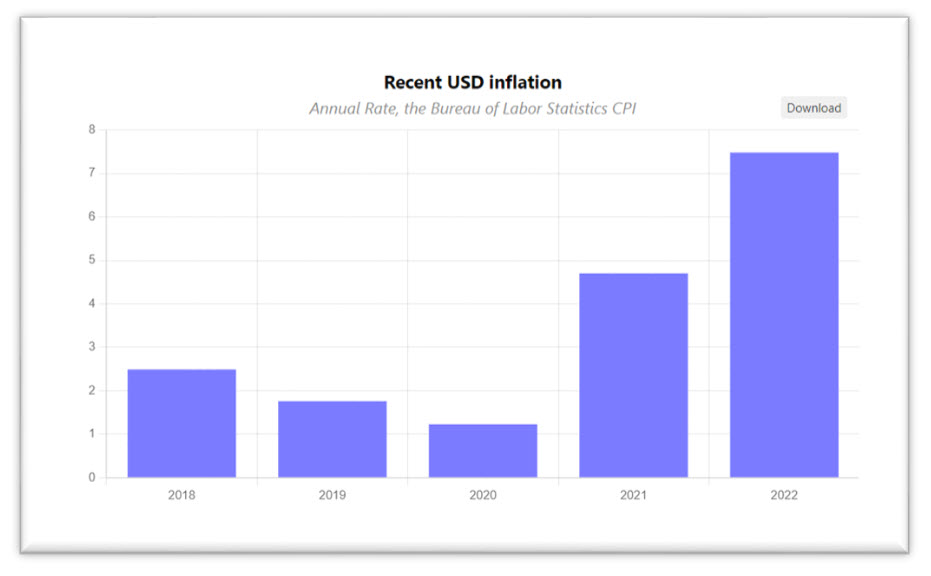By Mark Wright, OD, FCOVD,
and Carole Burns, OD, FCOVD

March 9, 2022
The conflict in Ukraine and rising inflation may seem far removed from your everyday concerns. However, the impact from world events are closer to home than you may think. What is happening in Ukraine may cause difficulty in your practice. Here’s how to plan in advance for the related likely challenges.
Inflation
Inflation is the 400 pound gorilla in the room. Anything that drives inflation upward causes price increases. Look at the price of a gallon of gasoline. According to the AAA, the national average price for a gallon of gasoline is above $4 with people in some states like California paying over $5.30/gal. Both CNBC and The New York Times report that we are paying the highest prices for gasoline since 2008.i
President Biden’s war on fossil fuels and the war in Ukraine are two major contributors to the increase in gasoline prices. As soon as he took office, President Biden began his war on fossil fuels resulting in increases in gas prices at the pump. Oil prices in recent weeks, as a result of the Ukraine invasion, have soared with the price per barrel now more than $130. Neither of these two situations look like they are going to resolve soon.
To make matters even more complicated, NATO is talking about a ban on Russian energy exports. What do you think that will do to the price of a barrel of oil? It will drive the price of a barrel of gas even higher.
Here’s inflation data from the Bureau of Labor Statistics:

We think trends give better insight than just one number alone. From the graph above, we can see the inflation trend for 2018 to 2020 is a gentle slope downward. This is what we like to see. But compare that trend with the sharp slope upward from 2020 to 2022. That 2020-2022 trend is a giant red flag and should concern all of us.
Let’s use an inflation calculator to see exactly how this impacts your practice.ii Let’s ask the question: how much money will I need to spend today to buy the same thing purchased in 2019? The inflation calculator tells us…

To say this a different way, because of inflation, from 2019 to 2022, $100 has the buying power of only $90.03 today.
The result of the increase in gasoline prices is that it costs more to transport materials (frames, lenses, contact lenses). When your optical laboratories have increased costs, those price increases are passed on to you and eventually you will need to pass those on to your patients. The net result is that just to stay even, you must address this issue.
One way is to increase your prices. The question is how much? From the inflation calculator above, you needed to increase your prices 9.97 percent when looking at the time period from 2019 to 2020. Examine your fee schedule from 2019 and then examine today’s fee schedule. Is your current fee schedule at least 9.97 percent higher than what you charged in 2019?
Other Articles to Explore
(The caveat here is that you are constrained by third parties on how much you can increase your prices. The result of this fact is you must focus your price increase on services and materials not covered by third parties.)
You have other options that are equally important to consider:
• Focus on the net rather than just the gross revenue collected. What do you need to do to increase the net by 9.97 percent when considering 2019 to 2022?
• Can you see more patients per hour?
• Can you increase your number of new patients?
• Can you decrease the number of patients you lose every year?
• Can you decrease your expenses through automation or elimination?
• Can you see your patients more frequently per year? (e.g.: we often see glaucoma patients with longer times between exams for optometrists than in ophthalmology practices)
Supply chain
What else can we predict? We have already seen supply chain slow-downs across the country. These delays impact the length of time it takes to get a job from the exam room to patients’ faces. As the war in Ukraine lengthens and deepens, especially as it eventually spreads beyond Ukraine’s borders, supply chains will be interrupted even more. These delays only cause problems within the practice.
One action you can take is to reduce the length of the supply chain. Buying products produced within the U.S. helps reduce the length of the supply chain.
You are not in this battle alone. Two notable contestants right now are EssilorLuxottica and VSP. Both are in a race to win the supply chain challenge. In the contact lens world some of the big players have moved their manufacturing out of the country.
Will this impact the delivery time?
If you stock lenses, where is the bank located? Ultimately, stay in close contact with all your vendors to make sure you are in the best position as we move forward.
Conclusion
Don’t wait until problems occur to start thinking about solutions. Don’t be reactive, be proactive. Take action today to prepare for the future.
References
i. Gas prices now exceed $4 a gallon, AAA says (kpax.com)
ii. $100 in 2019 → 2022 | Inflation Calculator (in2013dollars.com)



























